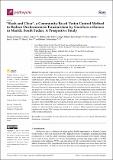| dc.contributor.author | Raimon, Stephen | |
| dc.contributor.author | Lakwo, Tom L. | |
| dc.contributor.author | Wilson, John Sebit | |
| dc.contributor.author | Nelson Siewe Fodjo, Joseph | |
| dc.contributor.author | Alinda, Peter | |
| dc.contributor.author | Carter, Jane Y. | |
| dc.contributor.author | Post, Rory J. | |
| dc.contributor.author | Colebunders, Robert | |
| dc.date.accessioned | 2021-11-17T19:59:22Z | |
| dc.date.available | 2021-11-17T19:59:22Z | |
| dc.date.issued | 2021-10-15 | |
| dc.identifier.citation | Raimon, S.; Lakwo, T.L.; Sebit, W.J.; Siewe Fodjo, J.N.; Alinda, P.; Carter, J.Y.; Post, R.J.; Colebunders, R. “Slash and Clear”, a Community- Based Vector Control Method to Reduce Onchocerciasis Transmission by Simulium sirbanum in Maridi, South Sudan: A Prospective Study. Pathogens 2021, 10, 1329. https:// doi.org/10.3390/pathogens10101329 | en_US |
| dc.identifier.other | https:// doi.org/10.3390/pathogens10101329 | |
| dc.identifier.uri | https://repository.amref.ac.ke/handle/123456789/382 | |
| dc.description | Copyright: © 2021 by the authors.
Licensee MDPI, Basel, Switzerland.
This article is an open access article
distributed under the terms and
conditions of the Creative Commons
Attribution (CC BY) license (https://
creativecommons.org/licenses/by/
4.0/). | en_US |
| dc.description.abstract | Abstract: Background: High ongoing Onchocerca volvulus transmission was recently documented in
Maridi County, South Sudan. To complement community-directed treatment with ivermectin (CDTI)
as the main onchocerciasis control strategy, we initiated a community-based vector control method
“slash and clear” at the Maridi dam, a Simulium damnosum s.l. breeding site, to reduce O. volvulus
transmission. Methods: Simulium damnosum s.l. biting rates were collected before and during the
twenty months following the “slash and clear” intervention using the human landing catches. Black
flies were dissected to measure parity rates before and twelve months after the intervention. Larvae
and pupae of S. damnosum s.l. were collected from the dam for morphological and chromosomal
characterization to identify the cytospecies involved. Results: Biting rates of S. damnosum s.l. close
to the Maridi dam spillway decreased by >90% post-“slash and clear” for more than six months.
Twelve months after the “slash and clear” intervention, the reduction in biting rates was still at <50%
(p = 0.0007). Parity rates reduced from 13% pre-“slash and clear” (November 2019) to 5.6% post-“slash
and clear” (November 2020). Larvae collected from the dam were identified as Simulium sirbanum.
Conclusion: The “slash and clear” method was found to be an effective and cheap community-based
method to reduce black fly biting rates caused by S. sirbanum. When repeated at least annually
together with a high CDTI coverage, this intervention has the potential to considerably accelerate
onchocerciasis elimination. | en_US |
| dc.description.sponsorship | The study was funded by an R2HC grant of Amref South Sudan (Project ID: 40385). | en_US |
| dc.language.iso | en | en_US |
| dc.publisher | Pathogens | en_US |
| dc.subject | Onchocerciasis; | en_US |
| dc.subject | Simulium damnosum | en_US |
| dc.subject | Simulium sirbanum | en_US |
| dc.subject | Vector control | en_US |
| dc.subject | Slash and clear | en_US |
| dc.subject | Elimination | en_US |
| dc.subject | Community | en_US |
| dc.title | “Slash and Clear”, a Community-Based Vector Control Method to Reduce Onchocerciasis Transmission by Simulium sirbanum in Maridi, South Sudan: A Prospective Study | en_US |
| dc.type | Article, Journal | en_US |

